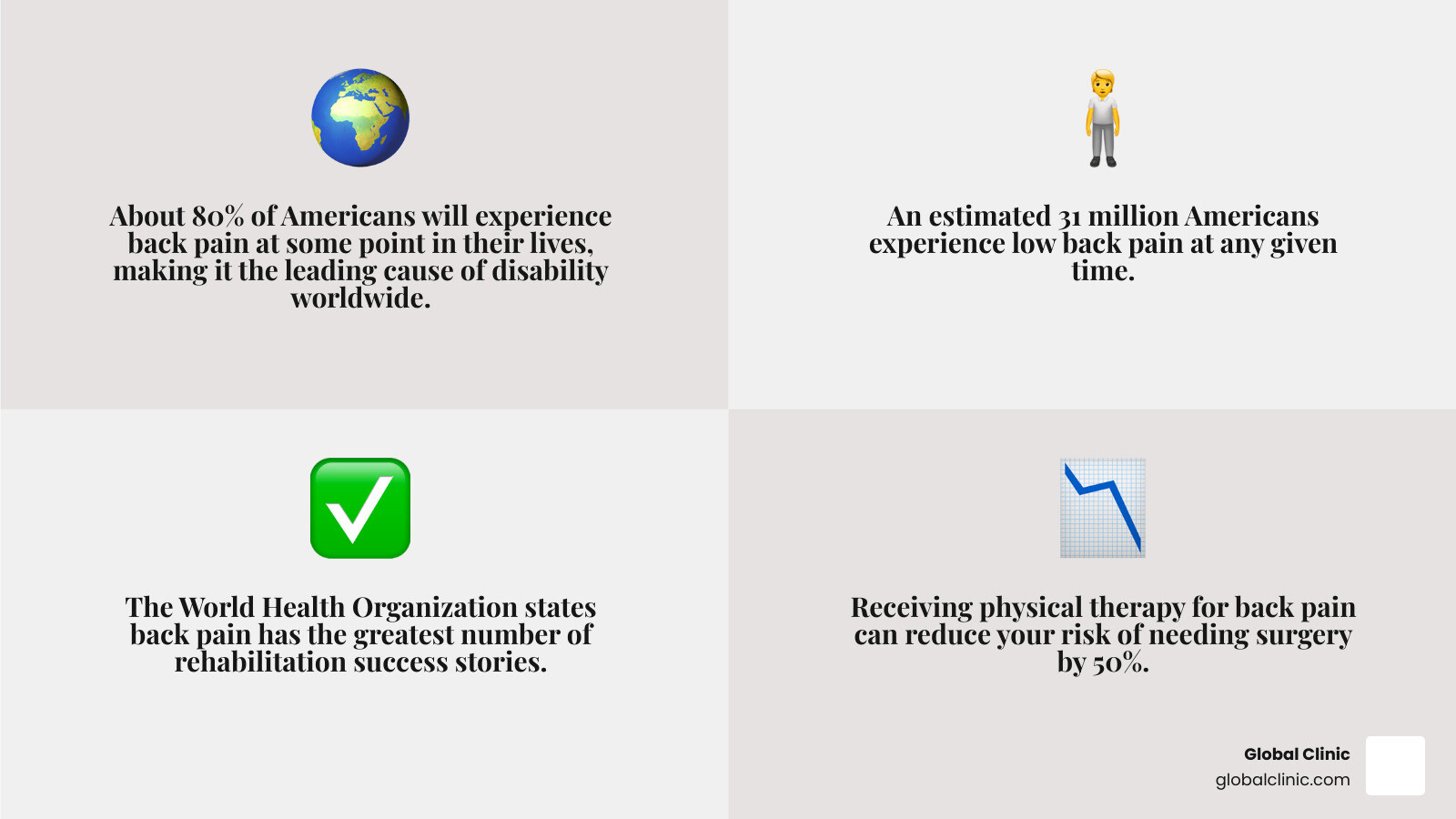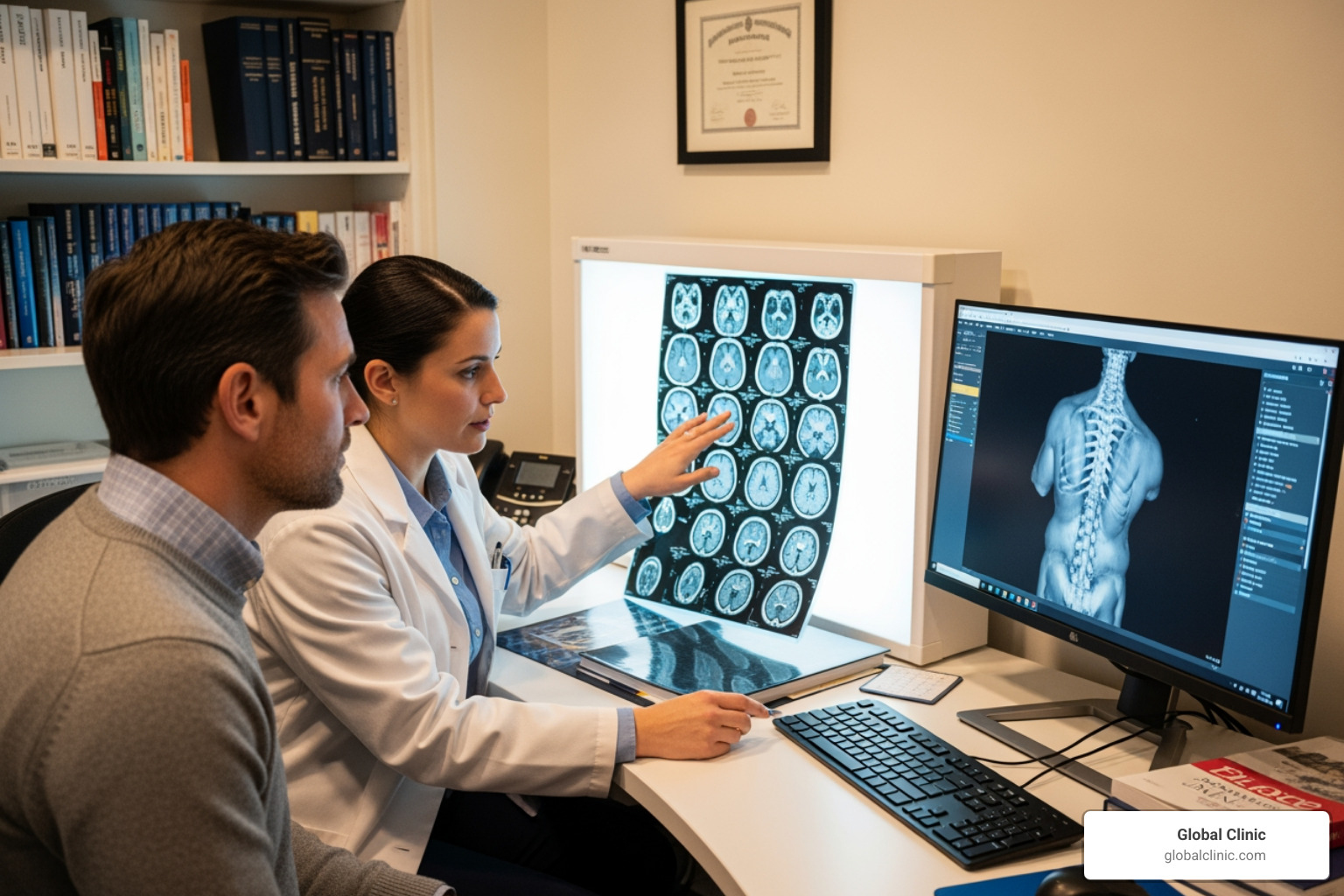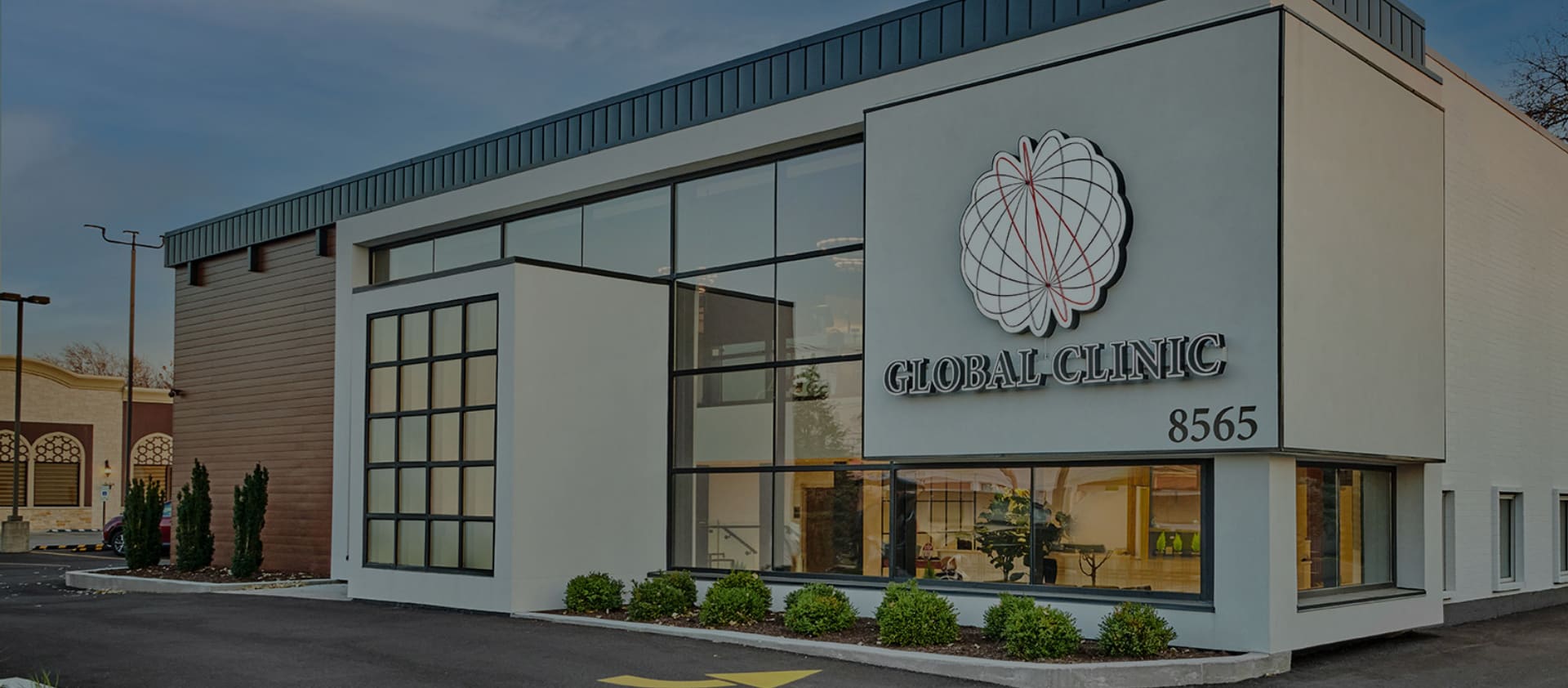Why Back Pain Affects 80% of Americans—And What You Can Do About It
Therapy for back pain includes a wide range of treatments to relieve discomfort and restore function. The primary options are:
- Physical Therapy: Customized exercises and manual therapy to build strength and flexibility.
- Chiropractic Care: Spinal adjustments to improve alignment and reduce nerve irritation.
- Medication: Pain relievers and muscle relaxants to manage acute symptoms.
- Injection Therapies: Targeted injections for temporary but powerful pain relief.
- Alternative Therapies: Acupuncture, massage, and yoga to complement traditional care.
- Lifestyle Modifications: Daily strategies like exercise, proper posture, and weight management.
Back pain is incredibly common. About 80% of Americans will experience it, making it a leading cause of disability worldwide. At any given time, an estimated 31 million Americans are dealing with low back pain. If you’re in Northern Chicago with an aching back, you are not alone.
The good news is that back pain has one of the highest rehabilitation success rates. Most cases improve within a month with conservative care. However, when pain becomes chronic (lasting over 12 weeks), therapy is critical. Research shows that starting physical therapy within 14 days of onset leads to better outcomes and can reduce your risk of needing surgery by 50%.
This guide covers the full spectrum of back pain therapies. I’m Ana Vinikov, Practice Manager at Global Pain & Spine Clinic, where I’ve helped patients in Northern Chicago find lasting relief for years. Our team uses a collaborative approach to help you get stronger and healthier.

Therapy for back vocab explained:
Understanding Back Pain: Types, Causes, and Symptoms
Before choosing a therapy for back pain, it’s important to understand the specific condition. Back pain is an umbrella term for many issues affecting the complex structure of bones, muscles, nerves, and discs in your back.
What are the different types of back pain?
We classify back pain by its duration, which helps guide treatment.
- Acute back pain is sudden and typically lasts from a few days to a few weeks. Most cases resolve within a month with home treatment.
- Subacute back pain lasts between 4 and 12 weeks. It’s more persistent but still responds well to conservative care.
- Chronic back pain lasts longer than 12 weeks. It can be frustrating, with periods of improvement followed by flare-ups, sometimes lasting for months or years.
What causes back pain?
Most back pain stems from a few main categories of issues.
Mechanical and structural problems are the most common. This includes:
- Muscle strains and ligament sprains from overexertion or awkward movements. Learn more about your specific back ache cause.
- Degenerative disc disease, where the discs between vertebrae wear down with age.
- Herniated or bulging discs, where a disc’s soft center pushes out and presses on a nerve.
- Sciatica, which is nerve pain, numbness, or tingling that travels from the lower back down the leg.
- Other issues like spinal stenosis (narrowing of the spinal canal), vertebral fractures, and scoliosis (abnormal curvature).
Inflammatory conditions like arthritis of the spine can cause stiffness and pain, especially in the morning.
Other medical conditions can also cause back pain, including osteoporosis, fibromyalgia, kidney problems, or infections. Additionally, about 50% of women experience back pain during pregnancy due to added weight and hormonal changes.
What are the risk factors for back pain?
Certain factors increase your risk, including:
- Age: Pain is more common after 45.
- Low fitness level: Weak core muscles provide less support for the spine.
- Weight gain: Extra weight, especially around the midsection, stresses the back.
- Job-related risks: Heavy lifting or prolonged sitting with poor posture.
- Psychological factors: Stress, anxiety, and depression can increase muscle tension and pain perception.
- Genetics and sedentary lifestyles also play a role.
What are the key symptoms of back pain?
Symptoms can vary widely, from a dull, constant ache to a sudden, sharp pain. Common signs include muscle soreness, stiffness, limited mobility, and pain that radiates down a leg (sciatica). Pain may worsen with bending, lifting, sitting, or standing.
When should you see a doctor for back pain?
Most back pain improves on its own, but some “red flag” symptoms require immediate medical attention. See a doctor right away if you experience:
- Pain that doesn’t improve after several weeks.
- Loss of bladder or bowel control.
- Numbness, tingling, or weakness in your legs.
- Pain accompanied by fever or unexplained weight loss.
- Pain resulting from a fall or injury.
- Severe night pain or loss of sensation in the groin area.
Getting the right diagnosis for your mid back pain or upper back spasm is the first step toward effective therapy for back pain.
The First Step: Diagnosing the Root Cause of Your Pain

An effective therapy for back pain plan starts with an accurate diagnosis. At Global Clinic, our Northern Chicago team focuses on pinpointing the root cause of your pain, not just masking symptoms.
Why is accurate diagnosis crucial?
Back pain isn’t one-size-fits-all. A herniated disc requires a different treatment approach than a muscle strain. A precise diagnosis prevents wasted time and ensures you receive the most effective care. Distinguishing between neurological (nerve-related) and musculoskeletal (muscle- and bone-related) pain is fundamental to creating your treatment plan.
What to expect during the diagnostic process
Your visit begins with a medical history review and a conversation. We listen to your story—when the pain started, what makes it better or worse, and how it impacts your life. This is followed by a physical examination where we assess your posture, range of motion, muscle strength, and reflexes to identify the source of the problem.
Understanding diagnostic tests
Based on your exam, we may recommend imaging or other tests to get a clearer picture.
- X-rays are good for showing bone problems like fractures, arthritis, or alignment issues, but they don’t visualize soft tissues like discs or nerves.
- MRI scans are the gold standard for soft tissues, providing detailed images of herniated discs, spinal stenosis, muscles, and nerves.
- CT scans offer detailed cross-sectional images of bone structures, useful for identifying bone spurs or fractures.
- Nerve studies (EMG) measure electrical activity to confirm if nerve pressure is causing your symptoms and to assess any nerve damage.
- Blood tests can help rule out underlying conditions like infections or inflammatory arthritis.
Our goal is to accurately identify your back ache cause so we can guide you to the right diagnosis and treatment options. Precision is the key to successful therapy for back pain.
Your Guide to Non-Surgical Therapy for Back Pain
At Global Clinic, our philosophy is to start with what works, not what’s most invasive. Most people find lasting relief with conservative, non-surgical therapy for back pain. We use a “stepped approach,” beginning with gentle, proven therapies and only moving to more advanced options if necessary.
Non-surgical treatments avoid the risks of surgery, generally cost less, and help your body heal itself. While some therapies may not work for everyone, we’ll work with you to find the right fit.
Physical Therapy: The Cornerstone of Recovery
Research overwhelmingly supports physical therapy as a first-line treatment for lower back pain. Starting early leads to better results and lower healthcare costs. In fact, patients who do physical therapy have a 50% lower risk of needing surgery.
At Global Clinic, your physical therapist will conduct an evaluation and create a customized exercise plan to strengthen your core, improve flexibility, and correct posture. They also use manual therapy—hands-on techniques like massage and joint mobilization—to reduce pain and improve movement. In most cases, you don’t need a physician referral to start. For acute pain, a few visits may be enough, while chronic pain typically requires more sessions over six to eight weeks.
Learn about addressing back pain with physical therapy and see how it can transform your recovery.
Chiropractic Care: A Hands-On Therapy for Back Pain
Chiropractic care focuses on the relationship between your spine and nervous system. The core of this therapy is spinal manipulation (adjustments), where a chiropractor applies controlled force to misaligned joints. This process aims to reduce nerve irritability, improve mobility, and restore proper function. It’s a safe and effective option for lower back pain, neck pain, and headaches, and is often used to treat back pain during pregnancy.
Explore our chiropractic services to see how we can help.
Complementary and Integrative Therapies
Combining traditional medicine with other healing practices can improve recovery.
- Acupuncture may help by stimulating nerves and boosting your body’s natural painkillers.
- Massage therapy is excellent for relaxing tense muscles, improving circulation, and reducing stress.
- Transcutaneous Electrical Nerve Stimulation (TENS) uses a small device to send gentle electrical currents that may block pain signals.
- Yoga and Tai Chi are mind-body practices that improve strength, posture, and stress levels.
Injection-Based and Pharmacologic Therapy for Back Pain
When pain is severe, medications and injections can provide enough relief to allow you to participate in other therapies.
-
Medications: Over-the-counter NSAIDs (ibuprofen) reduce inflammation. Doctors may prescribe muscle relaxants or certain antidepressants that affect pain perception. Opioids are used only for short-term, severe pain under close supervision due to risks of dependence.
-
Injection Treatments: These deliver medication directly to the pain source. Epidural steroid injections (cortisone shots) reduce inflammation around nerve roots, providing temporary relief. Nerve blocks interrupt pain signals. These treatments are not a permanent fix but a bridge to help you engage in long-term solutions like physical therapy.
The Role of Lifestyle and Home Management

Professional treatment is only part of the equation. The daily choices you make at home are a powerful form of therapy for back pain. Empowering yourself with self-care strategies is key to managing chronic pain and preventing recurrence.
Essential Exercises and Stretches for Back Health
Regular movement is a powerful tool for alleviating back pain. Your muscles need both strength and mobility. Gentle exercises like the knee-to-chest stretch, cat-cow stretch, bridge exercise, and pelvic tilts can build strength and reduce stiffness. Consistency is key—even a 5-minute daily routine can make a difference. For a structured plan, consider a 15-minute daily back exercise routine.
When to stop exercising: Pain is your body’s signal to stop. If an exercise hurts, stop slowly and try a different one. Always consult a healthcare provider before starting a new program, especially if you have an existing injury.
Diet, Posture, and Ergonomics: Your Daily Defense
Your daily habits have a profound impact on your back health.
-
Diet and Weight: An anti-inflammatory diet rich in whole foods can reduce discomfort. Maintaining a healthy weight is crucial, as excess weight, especially around the abdomen, puts significant stress on your spine.
-
Posture and Lifting: Sit with your feet flat on the floor and knees at a 90-degree angle. When lifting, always bend at your knees, not your waist, and keep the object close to your body.
-
Ergonomics and Footwear: Set up your workspace with your computer screen at eye level and use a chair with good lumbar support. Wear comfortable, supportive footwear with a low heel to maintain proper alignment.
-
Sleep and Stress: If you’re a side sleeper, place a pillow between your knees. If you sleep on your back, put a pillow under your knees. Avoid sleeping on your stomach. Manage stress through mindfulness or deep breathing, as it can cause muscle tension. Finally, quit smoking, as it reduces blood flow to the spine and hinders healing.
When to Consider Advanced and Surgical Interventions

At Global Clinic, we have seen countless patients in Northern Chicago find relief with conservative therapy for back pain. Surgery is not our starting point. However, for a small percentage of patients, it becomes the right path forward.
When is surgery considered?
Surgery is a last resort strategy, considered only after conservative treatments have been thoroughly tried without success. It is invasive, irreversible, and does not guarantee complete pain elimination.
However, certain “red flag” symptoms may require immediate surgical evaluation. Seek medical care right away for:
- Progressive muscle weakness in your legs or arms.
- Loss of bowel or bladder control (a medical emergency).
- Severe pain that doesn’t respond to rest or treatment.
- Pain following a significant fall or injury.
- Worsening numbness or tingling.
Types of Surgery for Back Pain
When surgery is necessary, the goal is to relieve pressure on nerves or stabilize the spine.
- Spinal decompression procedures create more space for nerves. This includes a discectomy (removing part of a herniated disc) or a laminectomy (removing bone to widen the spinal canal).
- Spinal fusion permanently joins two or more vertebrae to eliminate painful motion and provide stability.
Benefits and Risks of Surgery
For the right patient, surgery can fix structural problems and dramatically reduce pain. However, all surgeries carry risks, including infection, bleeding, blood clots, and potential nerve damage. Recovery can take months, and there’s always a chance the pain may not be fully relieved. This is why the decision to have surgery must be made carefully with your healthcare team.
We can help you understand all your lower back pain treatment near me options to make an informed decision.
Frequently Asked Questions about Back Pain Therapy
We’re here to provide clear answers about therapy for back pain. Here are some of the most common questions we hear from our patients in Northern Chicago.
What is the single best therapy for lower back pain?
There is no single magic bullet for back pain. The most successful treatment plans are personalized. That said, research consistently points to physical therapy as one of the most effective first-line treatments. It works by strengthening muscles and improving function, and it’s even more powerful when combined with other approaches like chiropractic care or lifestyle changes. The key is an accurate diagnosis to create a plan that’s custom specifically to you.
How long does it take for back pain therapy to work?
The timeline for recovery is unique to each person. For acute pain, you might see significant improvement within a few weeks. For chronic pain (lasting over 12 weeks), it may take six to eight weeks of consistent treatment to experience meaningful relief. Factors like your commitment to home exercises, overall health, and the specific cause of your pain all influence how quickly you’ll feel better. Your commitment is key—patients who stick to their programs are far more likely to reach their goals.
Should I stop all activity when my back hurts?
No, please don’t! This is a common myth. Prolonged bed rest can actually weaken your muscles and slow down recovery. Instead, we encourage smart, gentle activity like walking. It keeps blood flowing and prevents stiffness.
The key is to listen to your body. If a specific movement makes your pain worse, stop or modify it. But don’t let fear of pain keep you from all movement. Staying as active as possible within your comfort zone is a crucial part of managing low back pain. For more guidance, the National Institute of Arthritis and Musculoskeletal and Skin Diseases offers helpful resources on managing back pain.
Conclusion: Taking the First Step Towards a Pain-Free Life
As you’ve seen, therapy for back pain is not a one-size-fits-all solution. From physical therapy and chiropractic care to lifestyle changes and, when necessary, more advanced interventions, you have many options on your path to recovery.
The most encouraging truth is that back pain has one of the highest rehabilitation success rates of any medical condition. You are not stuck with this pain forever.
Your journey starts with the first step: seeking a personalized treatment plan. At Global Clinic, our team of physical therapists, chiropractors, and pain management specialists in Northern Chicago collaborates to create a plan for your unique situation. We combine our expertise to get you back to the life you love, stronger than before.
Patients who receive early therapy for back pain have better outcomes. Those who commit to their treatment plan are far more likely to achieve their recovery goals.
You don’t have to live with back pain. With the right support and your commitment, you can get back to doing the things you love. The path to a pain-free life starts with choosing to take action today.
Start your journey to recovery with our physical therapy programs and find what life feels like when back pain doesn’t call the shots anymore.


